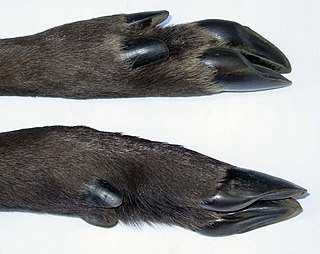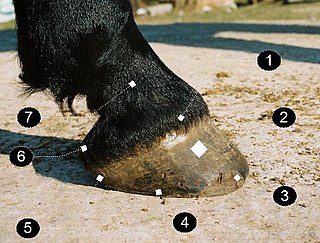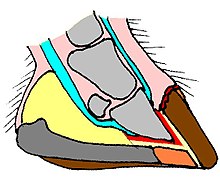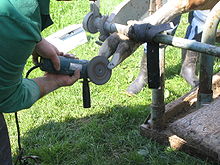
A horseshoe is a product designed to protect a horse hoof from wear. Shoes are attached on the palmar surface of the hooves, usually nailed through the insensitive hoof wall that is anatomically akin to the human toenail, although much larger and thicker. However, there are also cases where shoes are glued.

Perissodactyla is an order of ungulates. The order includes about 17 living species divided into three families: Equidae, Rhinocerotidae (rhinoceroses), and Tapiridae (tapirs). They typically have reduced the weight-bearing toes to three or one of the five original toes, though tapirs retain four toes on their front feet. The nonweight-bearing toes are either present, absent, vestigial, or positioned posteriorly. By contrast, artiodactyls bear most of their weight equally on four or two of the five toes: their third and fourth toes. Another difference between the two is that odd-toed ungulates digest plant cellulose in their intestines, rather than in one or more stomach chambers as even-toed ungulates, with the exception of Suina, do.

Ungulates are members of the diverse clade Euungulata which primarily consists of large mammals with hooves. Once part of the clade "Ungulata" along with the clade Paenungulata, "Ungulata" has since been determined to be a polyphyletic and thereby invalid clade based on molecular data. As a result, true ungulates had since been reclassified to the newer clade Euungulata in 2001 within the clade Laurasiatheria while Paenungulata has been reclassified to a distant clade Afrotheria. Living ungulates are divided into two orders: Perissodactyla including equines, rhinoceroses, and tapirs; and Artiodactyla including cattle, antelope, pigs, giraffes, camels, sheep, deer, and hippopotamuses, among others. Cetaceans such as whales, dolphins, and porpoises are also classified as artiodactyls, although they do not have hooves. Most terrestrial ungulates use the hoofed tips of their toes to support their body weight while standing or moving. Two other orders of ungulates, Notoungulata and Litopterna, both native to South America, became extinct at the end of the Pleistocene, around 12,000 years ago.

A claw is a curved, pointed appendage found at the end of a toe or finger in most amniotes. Some invertebrates such as beetles and spiders have somewhat similar fine, hooked structures at the end of the leg or tarsus for gripping a surface as they walk. The pincers of crabs, lobsters and scorpions, more formally known as their chelae, are sometimes called claws.

The navicular bone is a small bone found in the feet of most mammals.

A dewclaw is a digit– vestigial in some animals– on the foot of many mammals, birds, and reptiles. It commonly grows higher on the leg than the rest of the foot, such that in digitigrade or unguligrade species, it does not make contact with the ground when the animal is standing. The name refers to the dewclaw's alleged tendency to brush dew away from grass. On dogs and cats the dewclaws are on the inside of the front legs, similarly to a human's thumb, which shares evolutionary homology. Although many animals have dewclaws, other similar species do not, such as horses, giraffes and the African wild dog.

The phalanges are digital bones in the hands and feet of most vertebrates. In primates, the thumbs and big toes have two phalanges while the other digits have three phalanges. The phalanges are classed as long bones.

Laminitis is a disease that affects the feet of ungulates and is found mostly in horses and cattle. Clinical signs include foot tenderness progressing to inability to walk, increased digital pulses, and increased temperature in the hooves. Severe cases with outwardly visible clinical signs are known by the colloquial term founder, and progression of the disease will lead to perforation of the coffin bone through the sole of the hoof or being unable to stand up, requiring euthanasia.
Navicular syndrome, often called navicular disease, is a syndrome of lameness problems in horses. It most commonly describes an inflammation or degeneration of the navicular bone and its surrounding tissues, usually on the front feet. It can lead to significant and even disabling lameness.

Ringbone is exostosis in the pastern or coffin joint of a horse. In severe cases, the growth can encircle the bones, giving ringbone its name. It has been suggested by some authors that such a colloquial term, whilst commonly used, might be misleading and that it would be better to refer to this condition as osteoarthritis of the inter-phalangeal joints in ungulates.

A cloven hoof, cleft hoof, divided hoof, or split hoof is a hoof split into two toes. Members of the mammalian order Artiodactyla that possess this type of hoof include cattle, deer, pigs, antelopes, gazelles, goats, and sheep.

A horse hoof is the lower extremity of each leg of a horse, the part that makes contact with the ground and carries the weight of the animal. It is both hard and flexible. It is a complex structure surrounding the distal phalanx of the 3rd digit of each of the four limbs, which is covered by soft tissue and keratinised (cornified) matter. The arteries that supply the hoof with blood are, the vena plantaris externa and vena plantaris interna, which branch off the tibialis posterior. The horse hoof encapsules one of the three metatarsus bones that are found in the hoof and heel area.
A sickle-hocked leg structure is one in which the back leg joints of an animal, usually a horse or other equine mammal, are set with too much angle, resulting in the hock also being excessively angled. This can result in uneven hoof wear, which is incredibly painful for the affected horse. If the leg joints are not set properly, there is a high chance that the back joints are also set incorrectly, resulting in a poorly conformed horse.
Foot rot, also known as foul-in-the-foot, interdigital necrobacillosis or infectious pododermatitis, is a hoof infection commonly found in sheep, goats, and cattle. As the name suggests, it rots away the foot of the animal, more specifically the area between the two toes of the affected animal. It is extremely painful and contagious. It can be treated with a series of medications, but if not treated, the whole herd can become infected. The cause of the infection in cattle is two species of anaerobic bacteria, Fusobacterium necrophorum and Bacteroides melaninogenicus. Both bacteria are common to the environment in which cattle live, and Fusobacterium is present in the rumen and fecal matter of the cattle. In sheep, F. necrophorum first invades the interdigital skin following damage to the skin, and causes interdigital lesions and slight inflammation. The second stage of the disease is marked by the invasion of the foot by the foot rot bacterium Dichelobacter nodosus, a Gram-negative anaerobe. Usually, an injury to the skin between the hooves allows the bacteria to infect the animal. Another cause of foot rot may be high temperatures or humidity, causing the skin between the hooves to crack and let the bacteria infect the foot. This is one of the reasons foot rot is such a major problem in the summer. Foot rot is easily identifiable by its appearance and foul odor. Treatment is usually with an antibiotic medication, and preventing injury to the feet is the best way to prevent foot rot.
Dichelobacter nodosus, formerly Bacteroides nodosus, is a Gram-negative, obligate anaerobe of the family Cardiobacteriaceae. It has polar fimbriae and is the causative agent of ovine foot rot as well as interdigital dermatitis. It is the lone species in the genus Dichelobacter.
Lameness is an abnormal gait or stance of an animal that is the result of dysfunction of the locomotor system. In the horse, it is most commonly caused by pain, but can be due to neurologic or mechanical dysfunction. Lameness is a common veterinary problem in racehorses, sport horses, and pleasure horses. It is one of the most costly health problems for the equine industry, both monetarily for the cost of diagnosis and treatment, and for the cost of time off resulting in loss-of-use.

Natural hoof care is the practice of keeping horses so that their hooves are worn down naturally, or trimmed to emulate natural wear, so they do not suffer overgrowth, splitting and other disorders. Horseshoes are not used, but domesticated horses may still require trimming, exercise and other measures to maintain a natural shape and degree of wear.
In bovine podiatry, a cowslip is a tough plastic shoe used to treat lameness in cattle. It is applied onto the healthy claw with glue and allowed to set. The cowslip will raise the damaged claw off the ground and allow it to heal. The cowslip will slough in about 4–6 weeks and this is a principal advantage over a nail-on shoe which needs to be actively removed.

The limbs of the horse are structures made of dozens of bones, joints, muscles, tendons, and ligaments that support the weight of the equine body. They include two apparatuses: the suspensory apparatus, which carries much of the weight, prevents overextension of the joint and absorbs shock, and the stay apparatus, which locks major joints in the limbs, allowing horses to remain standing while relaxed or asleep. The limbs play a major part in the movement of the horse, with the legs performing the functions of absorbing impact, bearing weight, and providing thrust. In general, the majority of the weight is borne by the front legs, while the rear legs provide propulsion. The hooves are also important structures, providing support, traction and shock absorption, and containing structures that provide blood flow through the lower leg. As the horse developed as a cursorial animal, with a primary defense mechanism of running over hard ground, its legs evolved to the long, sturdy, light-weight, one-toed form seen today.
Digital dermatitis is a disease that causes lameness in cattle. It was first discovered in Italy in 1974 by Cheli and Mortellaro. This disease is caused by a mixture of different bacteria. Anaerobic bacteria, including spirochetes of the genus Treponema, are found in the lesions associated with the infection. Digital dermatitis is different from foot rot in cattle and both conditions may occur concurrently.



















